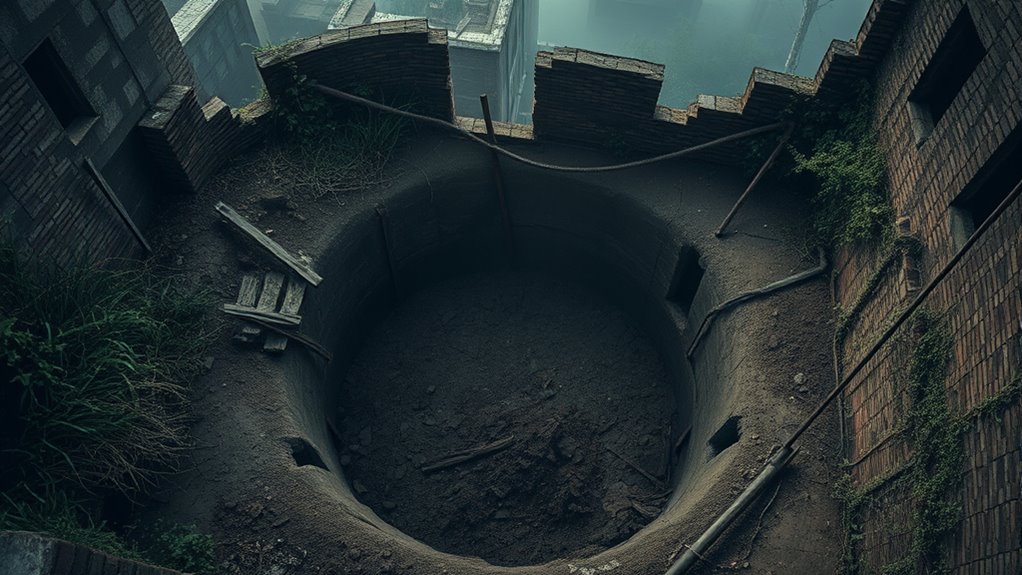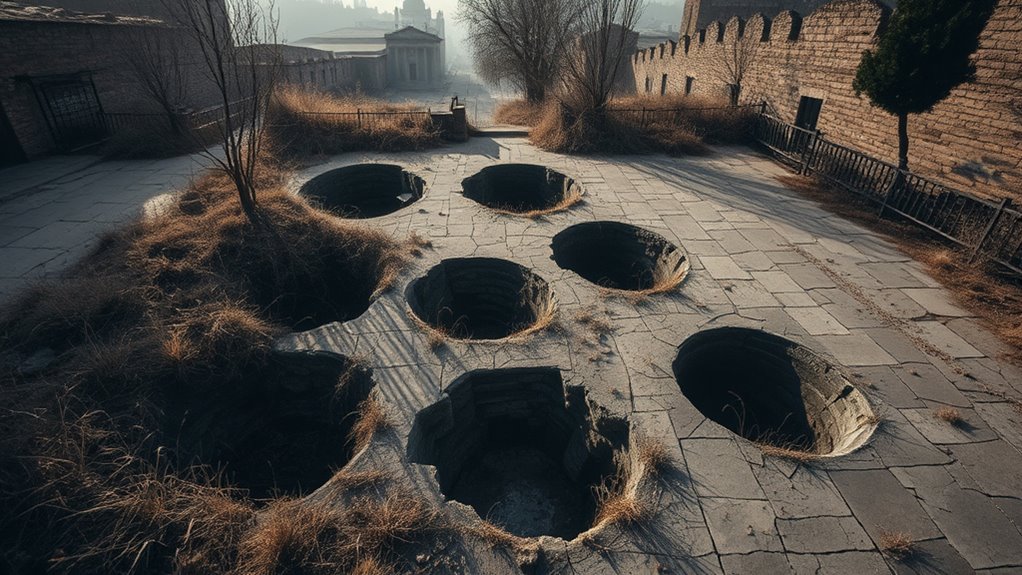Plague pits aren’t just mass graves from past epidemics—they’ve become woven into urban legends that blend history with fear and superstition. During crises like the Black Death, communities hurried to bury victims, often in unmarked pits, which later fueled stories of haunted or cursed sites. These legends help us understand collective anxieties about death and the supernatural, transforming somber history into myths that keep darker times alive in our collective memory. Discover more about how these stories shape our perception of history.
Key Takeaways
- Plague pits are mass graves from historical outbreaks, symbolizing urgent public health responses and societal trauma.
- Legends often exaggerate or supernaturalize plague pits, fueling stories of hauntings, curses, and ghosts.
- These sites serve as cultural symbols, representing mortality, mystery, and collective fears surrounding death and disease.
- Human tendency to mythologize tragedy leads to stories that fill gaps in history and process societal fears.
- Modern legends keep the memory of dark times alive, reflecting ongoing anxieties about death, disease, and supernatural forces.

Throughout history, the dark remnants of plague pits have fueled urban legends and haunted local imaginations. These mass graves, often hastily dug during times of crisis, symbolize more than just scientific evidence of past tragedies; they serve as the roots of myth creation. When you think about medieval burial practices, especially during outbreaks like the Black Death, you realize that communities faced a brutal necessity: bury the dead quickly to prevent further spread of disease. These hurried burials, often in large, unmarked pits, became the foundation for stories that blend fact and fiction, creating haunting legends that persist even today.
Hastily dug plague pits fueled legends, blending fact and fiction amid medieval fears of death and spirits.
In the medieval era, burial was a serious affair, rooted in religious and cultural beliefs, but during plague outbreaks, the urgency overshadowed tradition. You might imagine villagers rushing to dig mass graves, fearing that delay would turn their entire town into a breeding ground for death. Over time, these images of hurried, collective burials transformed into mythic tales. People started to see these pits not just as pragmatic solutions but as gateways to the unknown—places haunted by restless spirits or cursed by the collective suffering of thousands. Such stories often exaggerate the scale or supernatural elements, turning a somber necessity into a source of fear and fascination.
The creation of these myths around medieval burial sites often stemmed from a need to make sense of inexplicable death and chaos. When you hear stories about ghostly apparitions emerging from plague pits or hear whispers of curses from the buried, you’re witnessing the natural human tendency to mythologize tragedy. These legends serve as a way to grapple with the horror of mass death, transforming the stark reality of medieval burial into something more mysterious or sinister. The myth creation process is fueled by the gaps in historical record, the fear of the unknown, and the cultural memory of suffering.
As you explore older towns or haunted landscapes, it’s easy to see how these stories persist. They’re not just about the past—they shape local identities and collective fears. The dark, unmarked graves of the medieval period become symbols of mortality, mystery, and myth. The narratives spun around them often reflect deeper anxieties about death, disease, and the supernatural. Ultimately, the story of plague pits is a testament to how societies respond to trauma: through remembrance, myth creation, and the enduring power of stories that keep the memory of those dark times alive in the collective consciousness.
Frequently Asked Questions
Are Plague Pits Still Being Discovered Today?
Yes, plague pits are still being discovered today. During contemporary excavations, archaeologists often uncover these historic burial sites, especially in areas with dense urban development or past pandemics. These archaeological discoveries shed light on historical health crises and help us understand the scale of past outbreaks. While rare, such finds remind us that history is still revealing itself beneath our feet, offering valuable insights into the impact of pandemics on communities.
How Do Urban Legends About Plague Pits Develop?
Urban legends about plague pits develop through a mix of moral panic and folklore evolution. When people feel anxious or fearful, they create stories to explain or cope with these emotions. Over time, these tales spread and morph, becoming part of local folklore. This process amplifies rumors, making legends seem more mysterious or sinister, even if they aren’t based on factual events. Your curiosity fuels the ongoing evolution of these haunting stories.
What Are Common Misconceptions About Plague Pits?
Think of misconceptions about plague pits as shadows cast by old myths, misleading what burial practices truly entailed. You might believe they were mass graves filled with chaos, but history shows they were often organized and respectful. Many assume all pits are unmarked or forgotten, yet some served specific communities or were temporary. These historical myths distort reality, making you think of them as scenes from horror stories rather than carefully managed burial sites.
Do Plague Pits Influence Modern Public Health Policies?
You might think plague pits directly shape modern public health policies, but they mainly serve as historical lessons. They influence current practices by highlighting the importance of historical sanitation and modern disease control measures. While they don’t dictate policies today, understanding their history helps you appreciate the development of better sanitation systems and disease management strategies, ultimately guiding public health decisions and ensuring you’re better prepared for future outbreaks.
Are There Specific Cities More Associated With Plague Legends?
You might suspect some cities are more haunted by plague legends than others, and you’d be right. Cities like London, Florence, and Venice are steeped in medieval myths and city-specific stories about mass graves and dark secrets. These legends linger because of historical outbreaks, creating a chilling connection between past horrors and present curiosity. The stories remain, whispering of a time when death quietly claimed entire communities, leaving behind haunting tales.
Conclusion
As you uncover the stories behind plague pits and urban legends, you realize they’re like shadows cast by history’s darkest moments. These tales breathe life into the past, whispering secrets of fear and resilience. Understanding their origins helps you see through the myths to the truths beneath. Just as shadows dance in the flickering light, these legends remind you that history’s echoes always linger, shaping the stories we tell today.








